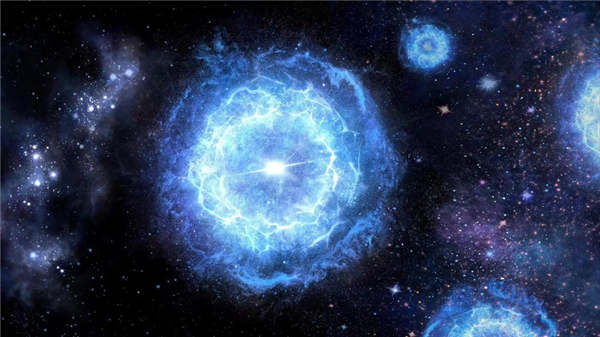
This image provided by the National Astronomical Observatories of China (NAOC) shows the first generation stars end up as a special type of supernovae, called pair-instability supernovae (PISN). (NAOC/Handout via Xinhua)
An international research team have discovered the oldest known star in the Galactic halo. Their findings indicate that it was born in the gas cloud left by a first generation star with a mass up to 260 times that of our Sun. This discovery has improved mankind's understanding of the first stars and the evolution of the Milky Way and the universe.
The new study led by Chinese astronomers at the National Astronomical Observatories of China (NAOC) under the Chinese Academy of Sciences (CAS) was published online in Nature on Wednesday.
Zhao Gang, leader of the research project, said that the first stars illuminated the universe during the cosmic dawn and put an end to the cosmic "dark ages" that followed the Big Bang. However, the distribution of their mass is one of the great unsolved mysteries of the cosmos.
Numerical simulations of the formation of the first stars estimate that the mass of the first stars could reach up to several hundred solar masses. Among them, the first stars with masses between 140 and 260 solar masses ended up as a special type of supernovae, called pair-instability supernovae (PISN), which would imprint a unique chemical signature in the atmosphere of the next generation of stars, said Zhao.
However, no direct evidence of such type of supernovae had been previously found.
Based on the survey by the Large Sky Area Multi-Object Fiber Spectroscopic Telescope (LAMOST) in China and the follow up observation by the Subaru telescope in Japan, scientists identified a chemically peculiar star, named LAMOST J1010+2358. Its special chemical characteristics are consistent with the theory of PISN. Scientists confirmed that this star was formed in the gas cloud dominated by the yields of a PISN with 260 solar masses.
"Our discovery is the first clear direct evidence of the existence of a PISN from a very massive first generation star in the early universe," said Xing Qianfan, a key member of the study from NAOC.
"This paper presents what is, to my knowledge, the first definitive association of a Galactic halo star with an abundance pattern originating from a PISN," said Timothy Beers, a professor with University of Notre Dame in the United States.
Wang Xiaofeng, a professor with Tsinghua University, said that the next generation stars carry the elemental imprints formed by the evolution and death of the previous generation stars. "It's like we can trace the characteristics of a child's father by examining the child's DNA."
This discovery proves that the mass of the first generation stars can reach up to several hundred solar masses, and will have a profound impact on the research of the origin of elements, star formation in the early universe, and the chemical evolution of galaxies, said Zhao.
"Understanding the properties of the first generation stars is crucial for us to understand the formation of stars, galaxies and large-scale structure of the universe," said Han Zhanwen, an academician of CAS.
"I think that this discovery, with many findings expected to come in the future, might shed light on the still unknown mechanism of very massive black hole formation in the early universe," said Toshitaka Kajino, a professor with the Beihang University.
Witnessing successful collaborations over the years between China's LAMOST and Japan's Subaru telescope, he said "we expect that many more important discoveries will be made by Asian astronomers, and enrich our understanding on when, how and where the atomic nuclei in the world and ourselves were synthesized and played the key roles in the evolution of the universe."

- China's telescope makes new finding on super massive first generation star
- China-made world’s 1st mid-infrared solar observation telescope nearing trial stage
- Chinese movie star Yen expresses his pride over nation’s amazing progress
- First super high plateau airport in SW China’s Xinjiang officially opens to traffic
- China-developed world’s largest steerable telescope, neutrino observatory listed among world’s major science events to watch for in 2023
- Next-generation rocket for astronauts expected in 2027
Popular Videos
Hot comments
- China Life: Chinese women shine with She Power
- First apes at U.S. zoo receive COVID-19 vaccine made for animals, zoo official says
- China-ASEAN Expo witnesses changes in tech, life over 18 years
- 86-year-old grandma in Hebei spends most her life on traditional cheongsam
- Homemade curling videos trending in China
- Lantern Festival: A romantic celebration in China
- Asia is young!
- Seven things you may not know about Lantern Festival
- Global Customer Day draws world-wide response
- RCEP agreement in effect for all 15 members
Top Reviews
- China to hold first nationwide Village BA tournament aiming to promote rural revitalization
- China's telescope makes new finding on super massive first generation star
- All-for-one tourism fair to meet visitors in Liuzhou
- Work begins on 2nd Chinese-invested expressway in Cambodia
- Xi urges Inner Mongolia to pursue green development, advance Chinese modernization
- Highlights of ICIF exhibition halls
- China launches reinsurance int'l board in Shanghai
- ASEAN media partners embark on a journey to discover the best of Guilin
- Free buses send students to exam venues in Guangxi
- Surging automobile exports drive auto transport ship manufacturing in China







